Rapid Oil Pyrolysis in Ediacaran Carbonate Reservoirs in the Central Sichuan Basin Revealed by Analysis of the Unique Optical and Raman Spectral Features of Pyrobitumen
Abstract
1. Introduction
2. Geological Setting
3. Samples and Methods
4. Results
4.1. Optical Characteristics of Pyrobitumen
4.2. Raman Spectra and Quantitative Results
5. Discussion
5.1. Thermal Maturity Distribution
5.2. Relationships Between Types of Pyrobitumen and Raman Parameters
5.3. Hydrothermal Effects on Reservoir Pyrobitumen
6. Conclusions
- Abundant pyrobitumen fills fractures, dissolution pores, and intercrystalline pores in the Ediacaran Dengying Formation reservoirs in the Penglai area, co-occurring with hydrothermal minerals, including saddle dolomite, quartz, and fluorite. Based on optical features, four types of pyrobitumen can be identified: type I (isotropic texture), type II (mosaic texture), type III (fibrous texture), and type IV (honeycomb texture).
- The equivalent vitrinite reflectance of reservoir pyrobitumen ranges from 3.46% to 3.89%, signifying an over-mature thermal maturity stage; however, this parameter exhibits minimal correlation with burial depths, implying that thermal maturation is not exclusively attributable to burial processes. There are significant differences in the Raman parameters between the four types of pyrobitumen: type IV manifests the highest degree of structural ordering, type II exhibits the greatest structure disordering, types I and III show intermediate structural ordering, types II-IV pyrobitumen are distributed near the fault zones, and Type I pyrobitumen is developed throughout the area, collectively reflecting a divergent structural evolution under varying hydrothermal regimes.
- Late Permian ELIP-derived hydrothermal pulses constitute the principal drivers of paleo-oil cracking into gas and the origin of hydrothermally structured pyrobitumen, exerting a significant influence on the contemporary gas reservoir configuration.
Supplementary Materials
Author Contributions
Funding
Institutional Review Board Statement
Informed Consent Statement
Data Availability Statement
Acknowledgments
Conflicts of Interest
References
- Li, C.Z.; Guo, P.; Dou, S.; Wen, H.G. Research Progress on Solid Bitumen Morphology, Genesis, and Application. Sediment. Geol. Sin. 2024, 42, 1479–1493, (In Chinese with English Abstract). [Google Scholar]
- Stasiuk, L.D. The Origin of Pyrobitumens in Upper Devonian Leduc Formation Gas Reservoirs, Alberta, Canada: An Optical and EDS Study of Oil to Gas Transformation. Mar. Pet. Geol. 1997, 14, 915–929. [Google Scholar] [CrossRef]
- Johannes, S.; Ralf, L.; Janos, L.U.; Peter, A.K.; Zuwena, R. Polyphase Thermal Evolution in the Infra-Cambrian Ara Group (South Oman Salt Basin) as Deduced by Maturity of Solid Reservoir Bitumen. Org. Geochem. 2007, 38, 1293–1318. [Google Scholar] [CrossRef]
- Mohamed, R.S.; Mohammed, H.H.; Wan, H.A. Geochemical Characterization of Solid Bitumen (Migrabitumen) in the Jurassic Sandstone Reservoir of the Tut Field, Shushan Basin, Northern Western Desert of Egypt. Int. J. Coal Geol. 2012, 100, 26–39. [Google Scholar] [CrossRef]
- Liu, D.; Li, J.; Xie, Z.Y.; Guo, J.Y.; Hao, A.S. Origin and Significance of Ediacaran Original and Coexist Bitumen of Central Sichuan Basin. Pet. Geol. Exp. 2014, 36, 218–223, (In Chinese with English Abstract). [Google Scholar]
- Maria, M.; Agnieszka, D.; Artur, B.S. Origin, Properties, and Implications of Solid Bitumen in Source-Rock Reservoirs: A Review. Int. J. Coal Geol. 2018, 195, 14–36. [Google Scholar] [CrossRef]
- Chen, Z.L.; Liu, G.D.; Cao, Z.L.; Guo, G.; Ren, J.L.; Yang, F.; Ma, W.Y. Origin of Solid Bitumen and Its Significance to Petroleum Geology: A Case Study of Baikouquan Formation in Mahu Sag of Junggar Basin. China Univ. Min. Technol. 2018, 47, 391–399, (In Chinese with English Abstract). [Google Scholar]
- Xu, G.S.; Xu, Y.L.; Yuan, H.F.; Ma, Y.S.; Cai, X.Y.; Cui, J.W. Geochemical Characteristics of Source Rocks and Reservoir Bitumen of Ediacaran–Lower Palaeozoic in the Middle–Southwest of Sichuan Basin. Oil Gas Technol. 2007, 29, 45–51, (In Chinese with English Abstract). [Google Scholar]
- Liu, D.H.; Xiao, X.M.; Tian, H.; Yang, C.; Hu, A.P.; Song, Z.G. Identification of Natural Gas Origin Using the Characteristics of Bitumen and Fluid Inclusions. Pet. Explor. Dev. 2009, 36, 375–382, (In Chinese with English Abstract). [Google Scholar]
- Xie, Z.Y.; Zhang, B.J.; Yang, C.L.; Dong, C.Y.; Pei, S.Q.; Zhao, J.; Guo, J.Y.; Zhang, L. Geochemical Characteristics and Source Trace of the Devonian Natural Gas and Bitumen in Northwest Sichuan Basin. Acta Pet. Sin. 2018, 39, 1103–1118, (In Chinese with English Abstract). [Google Scholar]
- Li, W.; Hu, G.Y.; Zhou, J.G. Asphalt Features and Gas Accumulation Mechanism of Ediacaran Reservoirs in the Tongwan Palaeo-Uplift, Sichuan Basin. Nat. Gas Ind. 2015, 35, 14–23, (In Chinese with English Abstract). [Google Scholar]
- Guo, X.S.; Hu, D.F.; Huang, R.C.; Duan, J.B.; Jiang, Z.L.; Zhu, X. Feature of Paleo-Oil Pools in the Ediacaran Dengying Formation, Northeastern Sichuan Basin, and Its Significance to Exploration. Oil Gas Geol. 2020, 41, 673–683, (In Chinese with English Abstract). [Google Scholar]
- Ma, X.H.; Yan, H.J.; Chen, J.Y.; He, D.B.; Xu, W. Development Patterns and Constraints of Superimposed Karst Reservoirs in Ediacaran Dengying Formation, Anyue Gas Field, Sichuan Basin. Oil Gas Geol. 2021, 42, 1281–1294, (In Chinese with English Abstract). [Google Scholar]
- Hao, B.; Zhao, W.Z.; Hu, S.Y.; Shi, S.Y.; Gao, P.; Wang, T.S.; Huang, S.P.; Jiang, H. Bitumen Genesis and Hydrocarbon Accumulation History of the Cambrian Longwangmiao Formation in Central Sichuan Basin. Acta Pet. Sin. 2017, 38, 863–875, (In Chinese with English Abstract). [Google Scholar]
- Jiang, Y.L.; Liu, X.J.; Zhao, X.Z.; Jin, F.M.; Liu, J.D.; Lv, X.Y. Comprehensive Identification of Oil and Gas Accumulation Period by Fluid Inclusion Technique and Reservoir Bitumen Characteristics: A Case Study of the Paleozoic Buried Hill in Beidagang, Huanghua Depression. Earth Sci. 2020, 45, 980–988, (In Chinese with English Abstract). [Google Scholar]
- Kuang, L.C.; Qi, X.F.; Wang, X.L.; Ren, J.L.; Tang, Y.; Pan, L.J. Discovery of Bulongguoer Ancient Reservoir in West Junggar, Xinjiang and Its Petroleum Geologic Significance. Acta Geol. Sin. 2011, 85, 224–233, (In Chinese with English Abstract). [Google Scholar]
- Lin, Y.; Li, X.W.; Chen, K.; Zhang, Y.T.; Zang, D.G.; Yu, Z. Key Seismic Techniques for Predicting Deep Marine Carbonate Reservoirs and the Effect Analysis: A Case Study on the Ediacaran-Cambrian Reservoirs in the Sichuan Basin and the Ordovician Reservoirs in the Tarim Basin. Oil Gas Geol. 2021, 42, 717–727, (In Chinese with English Abstract). [Google Scholar]
- Feng, G.X.; Chen, S.J. The Relationship between Asphalt Reflectance and Vitrinite Reflectance in Rocks. Nat. Gas Ind. 1988, 8, 20–25, (In Chinese with English Abstract). [Google Scholar]
- Jacob, H. Classification, Structure, Genesis and Practical Importance of Natural Solid Oil Bitumen (“Migrabitumen”). Int. J. Coal Geol. 1989, 11, 65–79. [Google Scholar] [CrossRef]
- Bertrand, R. Correlations among the Reflectances of Vitrinite, Chitinozoans, Graptolites and Scolecodonts. Org. Geochem. 1990, 15, 565–574. [Google Scholar] [CrossRef]
- Bertrand, R. Standardization of Solid Bitumen Reflectance to Vitrinite in Some Paleozoic Sequences of Canada. Energy Sources 1993, 15, 269–287. [Google Scholar] [CrossRef]
- Landis, C.R.; Castaño, J.R. Maturation and Bulk Chemical Properties of a Suite of Solid Hydrocarbons. Org. Geochem. 1995, 22, 137–149. [Google Scholar] [CrossRef]
- Petersen, H.I.; Schovsbo, N.H.; Nielsen, A.T. Reflectance Measurements of Zooclasts and Solid Bitumen in Lower Paleozoic Shales, Southern Scandinavia: Correlation to Vitrinite Reflectance. Int. J. Coal Geol. 2013, 114, 1–18. [Google Scholar] [CrossRef]
- Wang, Y.; Qiu, N.; Borjigin, T.; Shen, B.J.; Xie, X.M.; Ma, Z.L.; Lu, C.J.; Yang, Y.F.; Yang, L.; Cheng, L.J.; et al. Integrated Assessment of Thermal Maturity of the Upper Ordovician–Lower Silurian Wufeng–Longmaxi Shale in Sichuan Basin, China. Mar. Pet. Geol. 2019, 100, 447–465. [Google Scholar] [CrossRef]
- Li, C.Q.; Chen, H.H.; Xiao, X.W.; Wang, Z.C.; Jiang, H. Raman Spectroscopy of Bitumen from the Ediacaran Dengying Formation Reservoirs, Gaoshiti-Moxi Area, Central Sichuan Basin. Oil Gas Geol. 2022, 43, 456–466, (In Chinese with English Abstract). [Google Scholar]
- Price, L.C.; Baker, C.E. Suppression of Vitrinite Reflectance in Amorphous Rich Kerogen—A Major Unrecognized Problem. J. Pet. Geol. 1985, 8, 59–84. [Google Scholar] [CrossRef]
- Wilkins, R.W.; Wilmshurst, J.R.; Russell, N.J.; Hladky, G.; Ellacott, M.V.; Buckingham, C. Fluorescence Alteration and the Suppression of Vitrinite Reflectance. Org. Geochem. 1992, 18, 629–640. [Google Scholar] [CrossRef]
- Liu, D.H.; Xiao, X.M.; Tian, H.; Min, Y.S.; Zhou, Q.; Cheng, P.; Shen, J.G. Sample Maturation Calculated Using Raman Spectroscopic Parameters for Solid Organics: Methodology and Geological Applications. Chin. Sci. Bull. 2013, 58, 1285–1298, (In Chinese with English Abstract). [Google Scholar] [CrossRef]
- Gonçalves, P.A.; Mendonça Filho, J.G.; da Silva, F.S.; Flores, D. Reprint of “Solid Bitumen Occurrences in the Arruda Sub-Basin (Lusitanian Basin, Portugal): Petrographic Features”. Int. J. Coal Geol. 2015, 139, 217–227. [Google Scholar] [CrossRef]
- Wilkins, R.W.; Sherwood, N.; Li, Z. RaMM (Raman Maturity Method) Study of Samples Used in an Interlaboratory Exercise on a Standard Test Method for Determination of Vitrinite Reflectance on Dispersed Organic Matter in Rocks. Mar. Pet. Geol. 2018, 91, 236–250. [Google Scholar] [CrossRef]
- Henry, D.G.; Jarvis, I.; Gillmore, G.; Stephenson, M. Raman Spectroscopy as a Tool to Determine the Thermal Maturity of Organic Matter: Application to Sedimentary, Metamorphic and Structural Geology. Earth-Sci. Rev. 2019, 198, 102936. [Google Scholar] [CrossRef]
- Yang, Y.; Wen, L.; Song, Z.Z.; Yan, W.; Zhou, G.; Tian, X.W.; Zhong, Y.; Ma, K.; Li, K.F.; Yang, D.L.; et al. Breakthrough and Potential of Natural Gas Exploration in Multi-Layer System of Penglai Gas Area in the North of Central Sichuan Paleo-Uplift. Acta Pet. Sin. 2022, 43, 1351–1368+1394, (In Chinese with English Abstract). [Google Scholar]
- Liu, S.G.; Ma, Y.S.; Cai, X.Y.; Xu, G.S.; Wang, G.Z.; Yong, Z.Q.; Sun, W.; Yuan, H.F.; Pan, C.L. Characteristic and Accumulation Process of the Natural Gas from Sinian to Lower Paleozoic in Sichuan Basin, China. Chengdu Univ. Technol. 2009, 36, 345–354, (In Chinese with English Abstract). [Google Scholar]
- Wang, G.Z.; Liu, S.G.; Liu, W.; Fan, L.; Yuan, H.F. Process of Hydrocarbon Accumulation of Sinian Dengying Formation in Gaoshiti Structure, Central Sichuan, China. Chengdu Univ. Technol. 2014, 41, 684–693, (In Chinese with English Abstract). [Google Scholar]
- Shen, A.J.; Zhao, W.Z.; Hu, A.P.; Wang, H.; Liang, F.; Wang, Y.S. The Dating and Temperature Measurement Technologies for Carbonate Minerals and Their Application in Hydrocarbon Accumulation Research in the Paleo-Uplift in Central Sichuan Basin, SW China. Pet. Explor. Dev. 2021, 48, 476–487, (In Chinese with English Abstract). [Google Scholar] [CrossRef]
- Gao, P.; Liu, G.; Lash, G.G.; Li, B.Y.; Yan, D.T.; Chen, C. Occurrences and Origin of Reservoir Solid Bitumen in Sinian Dengying Formation Dolomites of the Sichuan Basin, SW China. Int. J. Coal Geol. 2018, 200, 135–152. [Google Scholar] [CrossRef]
- Yang, C.Y.; Ni, Z.Y.; Li, M.J.; Wang, T.G.; Chen, Z.G.; Hong, H.T.; Tian, X.W. Pyrobitumen in South China: Organic Petrology, Chemical Composition and Geological Significance. Int. J. Coal Geol. 2018, 188, 51–63. [Google Scholar] [CrossRef]
- Niu, S.Q.; Liu, G.D.; Wang, Y.L.; Song, Z.Z.; Zhu, L.Q.; Zhao, W.Z.; Tian, X.W.; Yang, D.L.; Li, Y.S. Occurrence Characteristics and Genesis Mechanism of Pyrobitumen in Ediacaran Dengying to Cambrian Longwangmiao Reservoirs in Central Sichuan Basin. Pet. Geol. Exp. 2024, 46, 1039–1049, (In Chinese with English Abstract). [Google Scholar]
- Liu, W.; Qiu, N.; Xu, Q.; Liu, Y.F. Precambrian Temperature and Pressure System of Gaoshiti-Moxi Block in the Central Paleo-Uplift of Sichuan Basin, Southwest China. Precambrian Res. 2018, 313, 91–108. [Google Scholar] [CrossRef]
- Zhang, B.J.; Zhou, G.; Song, Z.Z.; Yan, W.; Wang, H.; Tao, J.L.; Tian, X.W.; Ding, X.H.; Zhong, Y.; Ma, K.; et al. Multi-Layers Three-Dimensional Natural Gas Accumulation of the Upper Ediacaran -Lower Cambrian Marine Carbonate Rocks in Penglai Gas Area, North Slope of Central Sichuan Paleo-Uplift. Mar. Orig. Pet. Geol. 2023, 28, 401–412, (In Chinese with English Abstract). [Google Scholar]
- Chen, Z.Q. Gas Exploration in Ediacaran Dengying Formation, Sichuan Basin. China Pet. Explor. 2010, 15, 1–14, (In Chinese with English Abstract). [Google Scholar]
- Liu, Y.F.; Qiu, N.S.; Xie, Z.Y.; Yao, Q.Y.; Zhu, C.Q. Overpressure Compartments in the Central Paleo-Uplift, Sichuan Basin, Southwest China. AAPG Bull. 2016, 100, 867–888. [Google Scholar] [CrossRef]
- Fan, J.J.; Jiang, H.; Lu, X.S.; Liu, Q.; Liu, S.B.; Ma, X.Z.; Huang, S.P.; Zeng, F.Y.; Tian, H.; Xie, W.R. Pressure Evolution and Hydrocarbon Accumulation Process of Ediacaran Dengying Formation Gas Reservoirs in the Penglai Area, Sichuan Basin. Nat. Gas Ind. 2022, 42, 32–43, (In Chinese with English Abstract). [Google Scholar]
- Jiang, Y.Q.; Tao, Y.Z.; Gu, Y.F.; Wang, J.B.; Qiang, Z.T.; Jiang, N.; Lin, G.; Jiang, G. Hydrothermal Dolomitization in Ediacaran Dengying Formation, Gaoshiti-Moxi Area, Sichuan Basin, SW China. Pet. Explor. Dev. 2016, 43, 51–60, (In Chinese with English Abstract). [Google Scholar] [CrossRef]
- Yuan, H.F.; Liu, Y.; Xu, F.H.; Wang, G.Z.; Xu, G.S. The Fluid Charge and Hydrocarbon Accumulation, Ediacaran Reservoir, Anpingdian-Gaoshiti Structure, Central Sichuan Basin. Acta Pet. Sin. 2014, 30, 727–736, (In Chinese with English Abstract). [Google Scholar]
- Liu, S.G.; Sun, W.; Zhao, Y.H.; Wang, G.Z.; Song, L.K.; Deng, B.; Liang, F.; Song, J.M. Differential Accumulation and Distribution of Natural Gas and Their Main Controlling Factors in the Upper Ediacaran Dengying Fm, Sichuan Basin. Nat. Gas Ind. 2015, 35, 10–23, (In Chinese with English Abstract). [Google Scholar]
- Li, J.J.; Cao, Q.; Lu, S.F.; Wang, W.M.; LI, W.H.; Yan, X.T.; Shi, Y.L.; Yin, J.X. History of Natural Gas Accumulation in Leshan-Longnvsi Ediacaran Paleo-Uplift, Sichuan Basin. Oil Gas Geol. 2016, 37, 30–36, (In Chinese with English Abstract). [Google Scholar]
- Yang, C.Y.; Wen, L.; Wang, T.G.; Luo, B.; Li, M.J.; Tian, X.W.; Ni, Z.Y. Timing of Hydrocarbon Accumulation for Paleo-Oil Reservoirs in Anyue Gas Field in Chuanzhong Uplift. Oil Gas Geol. 2020, 41, 492–502, (In Chinese with English Abstract). [Google Scholar]
- Court, R.W.; Sephton, M.A.; Parnell, J.; Gilmour, I. Raman Spectroscopy of Irradiated Organic Matter. Geochim. Cosmochim. Acta 2007, 71, 2547–2568. [Google Scholar] [CrossRef]
- Zhou, Q.; Xiao, X.M.; Pan, L.; Tian, H. The Relationship between Micro-Raman Spectral Parameters and Reflectance of Solid Bitumen. Int. J. Coal Geol. 2014, 121, 19–25. [Google Scholar] [CrossRef]
- Wang, M.L.; Xiao, X.M.; Wei, Q.; Zhou, Q. Thermal Maturation of Solid Bitumen in Shale as Revealed by Raman Spectroscopy. Nat. Gas Geosci. 2015, 26, 1712–1718, (In Chinese with English Abstract). [Google Scholar]
- Xiao, X.M.; Zhou, Q.; Cheng, P.; Sun, J.; Liu, D.H.; Tian, H. Thermal Maturation as Revealed by Micro-Raman Spectroscopy of Mineral-Organic Aggregation (MOA) in Marine Shales with High and Over Maturities. Sci. China Earth Sci. 2020, 63, 1540–1552. [Google Scholar] [CrossRef]
- Hu, S.; Evans, K.; Craw, D.; Rempel, K.; Bourdet, J.; Dick, J.; Grice, K. Raman Characterization of Carbonaceous Material in the Macraes Orogenic Gold Deposit and Metasedimentary Host Rocks, New Zealand. Ore Geol. Rev. 2015, 70, 80–95. [Google Scholar] [CrossRef]
- Kaneki, S.; Kouketsu, Y.; Aoya, M.; Nakamura, Y.; Wallis, S.R.; Shimura, Y.; Yamaoka, K. An Automatic Peak Deconvolution Code for Raman Spectra of Carbonaceous Material and a Revised Geothermometer for Intermediate to Moderately High-Grade Metamorphism. Prog. Earth Planet. Sci. 2024, 11, 35. [Google Scholar] [CrossRef]
- Zhu, L.Q.; Liu, G.D.; Song, Z.Z.; Zhang, B.J.; Zhao, W.Z.; Tian, X.W.; Ma, K.; Wang, Y.L.; Yang, D.L.; Li, Q.; et al. Hydrothermal Activity in Ultra-Deep Strata and Its Geological Significance for Deep Earth Gas Exploration: Implications from Pyrobitumen in the Ediacaran-Lower Cambrian Strata, Sichuan Basin. Int. J. Coal Geol. 2022, 259, 104030. [Google Scholar] [CrossRef]
- Klett, J.W. Process for Making Carbon Foam. U.S. Patent 6033506, 7 March 2000. [Google Scholar]
- Yang, C.Y.; Li, M.J.; Ni, Z.Y.; Wang, T.G.; Qiu, N.S.; Fang, R.H.; Wen, L. Paleo-Oil Reservoir Pyrolysis and Gas Release in the Yangtze Block Imply an Alternative Mechanism for the Late Permian Crisis. Geosci. Front. 2022, 13, 101324. [Google Scholar] [CrossRef]
- White, J.L. Mesophase Mechanisms in the Formation of the Microstructure of Petroleum Coke. Am. Chem. Soc. 1976, 21, 282–314. [Google Scholar]
- Lewis, I.C. Thermal Polymerization of Aromatic Hydrocarbons. Carbon 1980, 18, 191–196. [Google Scholar] [CrossRef]
- Jiang, H.; Wang, Z.C.; Du, H.Y.; Zhang, C.M.; Wang, R.J.; Zou, N.N.; Wang, T.S.; Gu, Z.D.; Li, Y.X. Tectonic Evolution of the Leshan-Longnvsi Paleo-Uplift and Reservoir Formation of Neoproterozoic Sinian Gas. Nat. Gas Geosci. 2014, 25, 192–200. [Google Scholar]
- Zou, C.N.; Du, J.H.; Xu, C.C.; Wang, Z.C.; Zhang, B.M.; Wei, G.Q.; Wang, T.S.; Yao, G.S.; Deng, S.H.; Liu, J.J.; et al. Formation, Distribution, Resource Potential, and Discovery of Sinian-Cambrian Giant Gas Field, Sichuan Basin, SW China. Pet. Explor. Dev. 2014, 41, 306–325. [Google Scholar] [CrossRef]
- Zhu, C.Q.; Hu, S.B.; Qiu, N.S.; Rao, S.; Yuan, Y.S. The Thermal History of the Sichuan Basin, SW China: Evidence from the Deep Boreholes. Sci. China Earth Sci. 2016, 59, 70–82. [Google Scholar] [CrossRef]
- Yang, C.Y.; Ni, Z.Y.; Wang, T.G.; Chen, Z.Z.; Hong, H.T.; Wen, L.; Luo, B.; Wang, W.Z. A New Genetic Mechanism of Natural Gas Accumulation. Sci. Rep. 2018, 8, 8336. [Google Scholar] [CrossRef]
- Boven, A.; Pasteels, P.; Punzalan, L.E.; Liu, J.; Luo, X.; Zhang, W.; Guo, Z.; Hertogen, J. 40Ar/39Ar Geochronological Constraints on the Age and Evolution of the Permo-Triassic Emeishan Volcanic Province, SW China. J. Asian Earth Sci. 2002, 20, 157–175. [Google Scholar] [CrossRef]
- Zhang, C.Q.; Rui, Z.Y.; Chen, Y.C.; Wang, C.H.; Chen, Z.H.; Lou, D.B. The Main Successive Strategic Bases of Resources for Pb-Zn Deposits in China. Geol. China 2013, 40, 248–272, (In Chinese with English Abstract). [Google Scholar]
- Yuan, B.; Mao, J.W.; Yan, X.H.; Wu, Y.; Zhang, F.; Zhao, L.L. Sources of Metallogenic Materials and Metallogenic Mechanism of Daliangzi Ore Field in Sichuan Province: Constraints from Geochemistry of S, C, H, O, Sr Isotope and Trace Element in Sphalerite. Acta Pet. Sin. 2014, 30, 209–220, (In Chinese with English Abstract). [Google Scholar]
- Shellnutt, J.G. The Emeishan large igneous province: A synthesis. Geosci. Front. 2014, 5, 369–394. [Google Scholar] [CrossRef]
- Chen, C.S.; Qin, S.F.; Wang, Y.P.; Holland, G.; Wynn, P.; Zhong, W.X.; Zhou, Z. High-Temperature Methane Emissions from Large Igneous Provinces as Contributors to Late Permian Mass Extinctions. Nat. Commun. 2022, 13, 6893. [Google Scholar] [CrossRef] [PubMed]

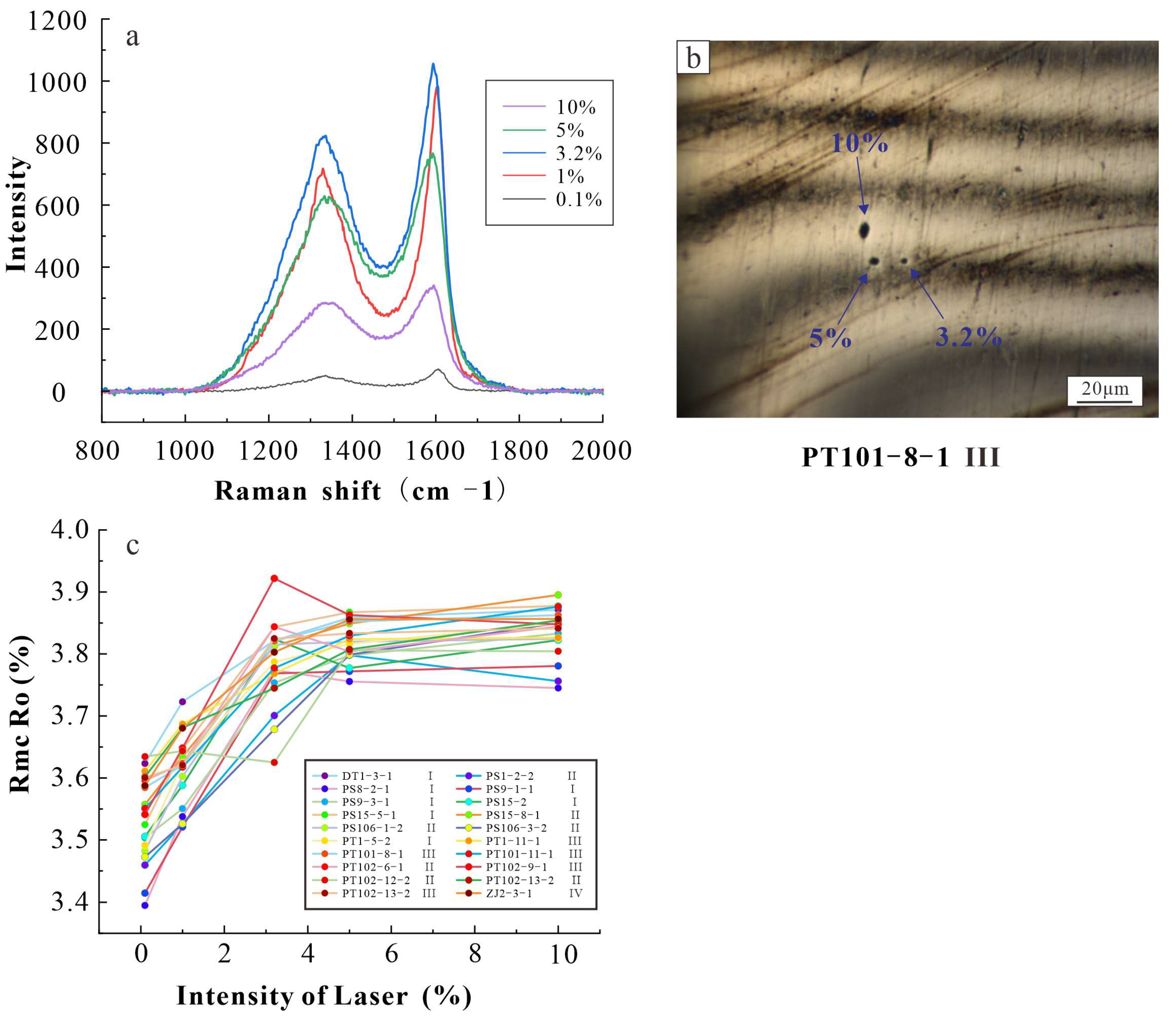

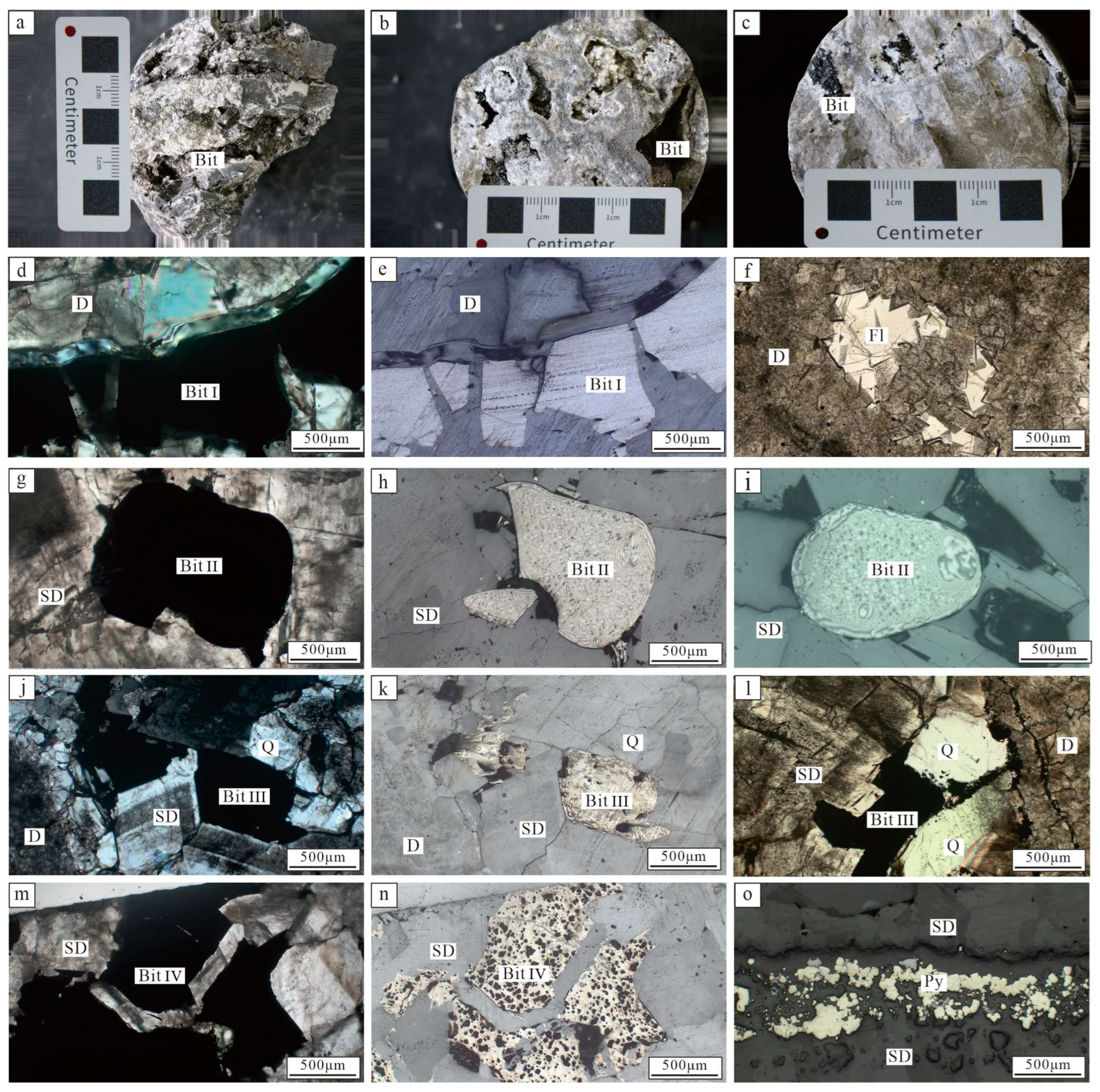
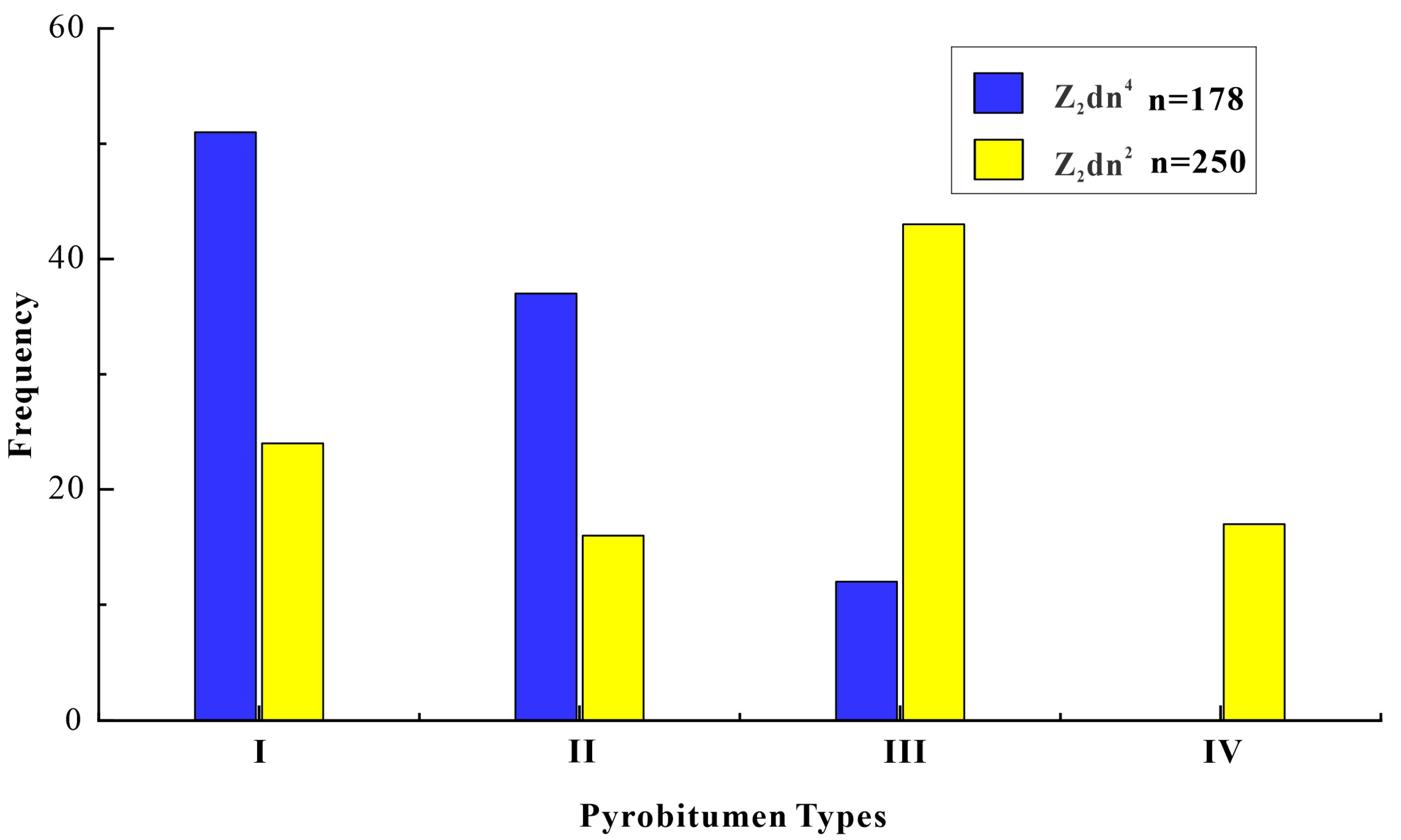
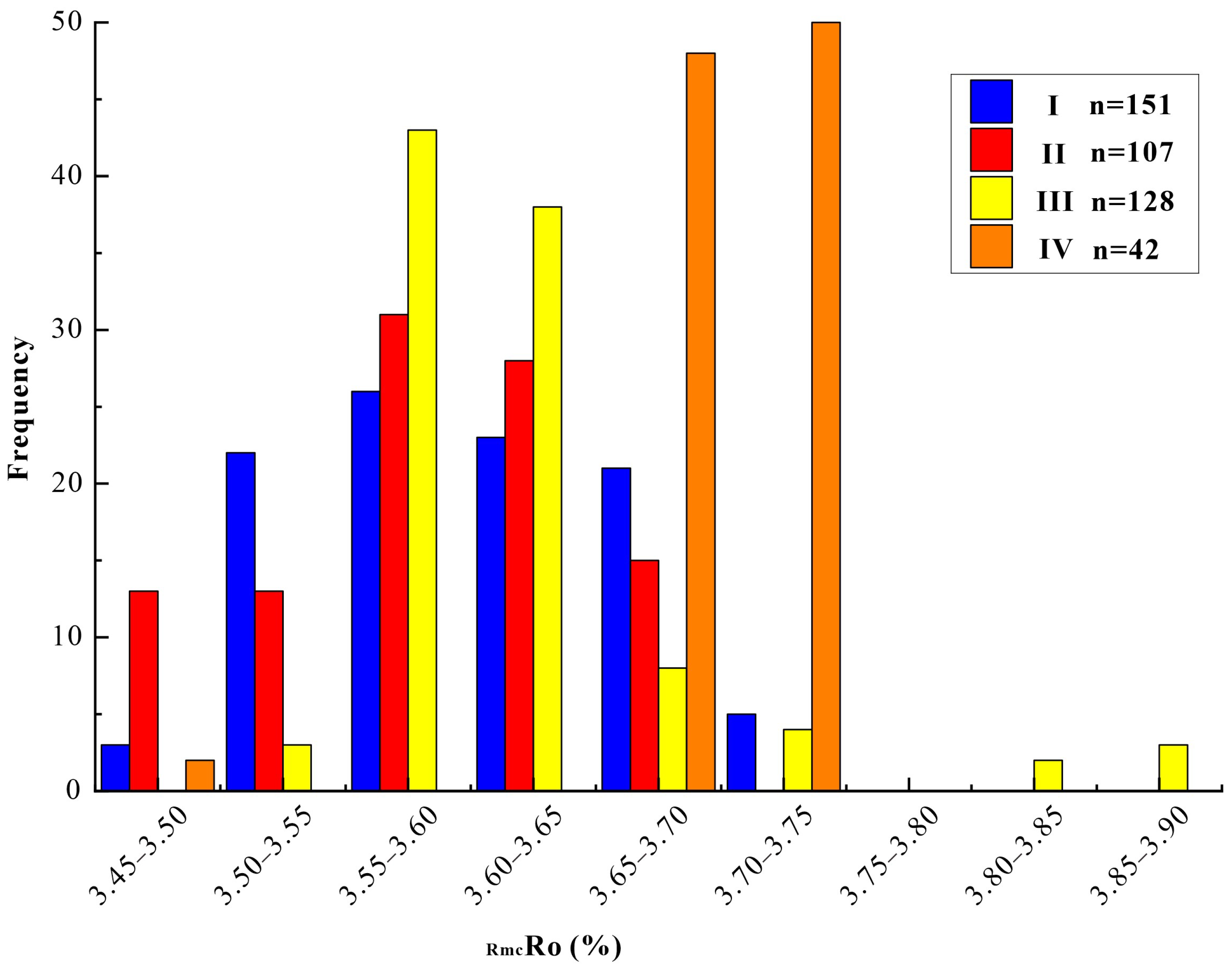
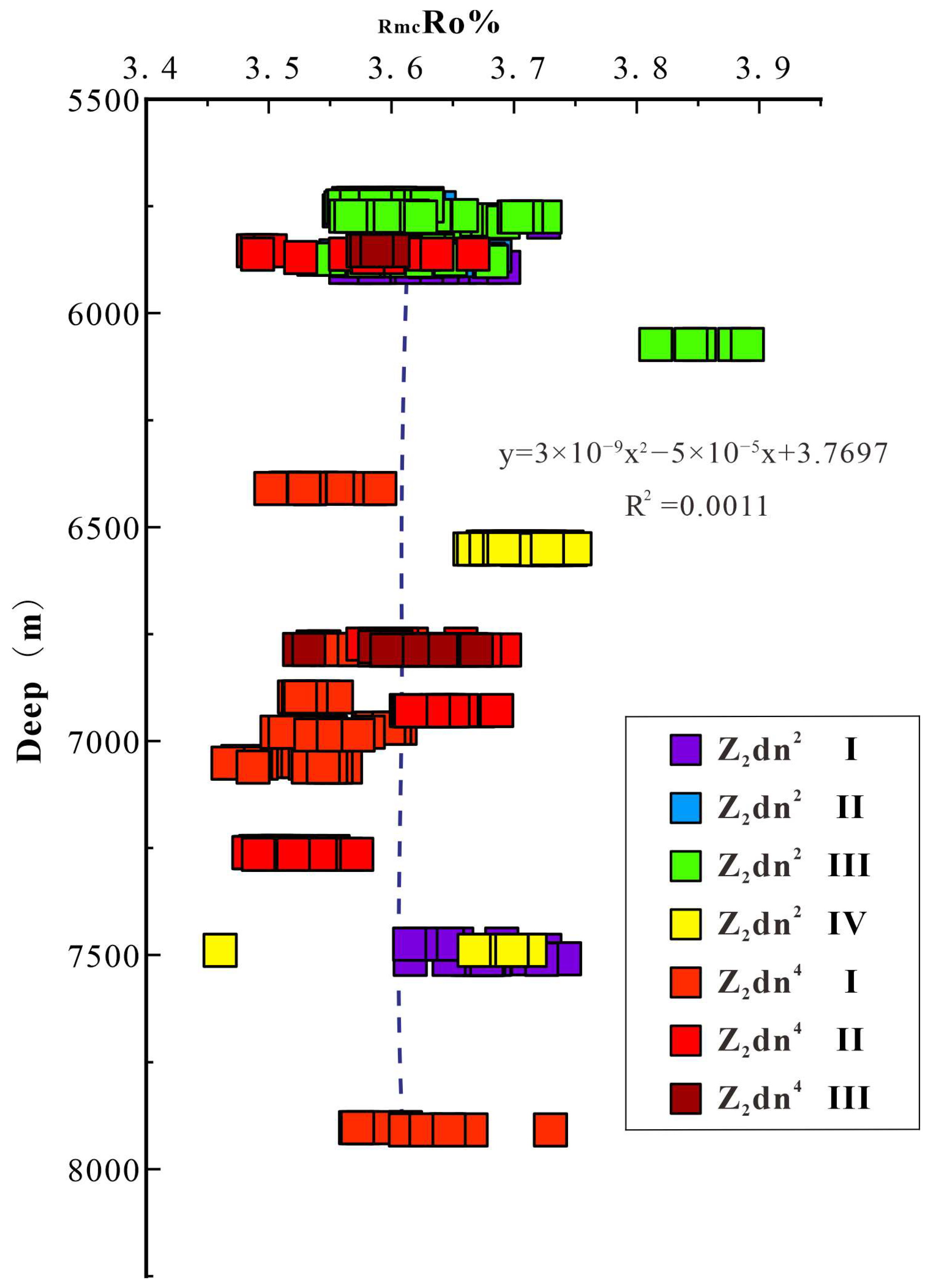

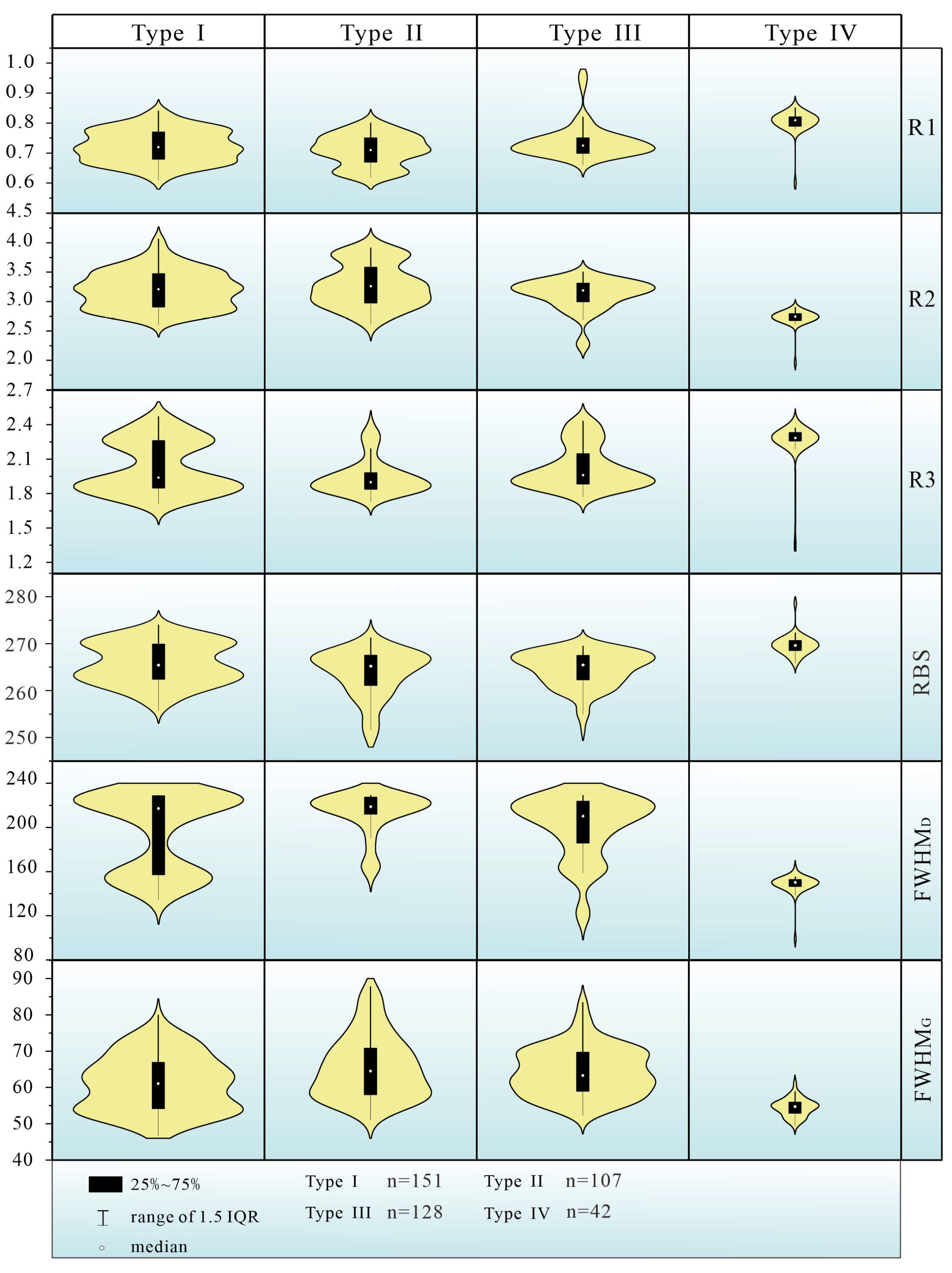

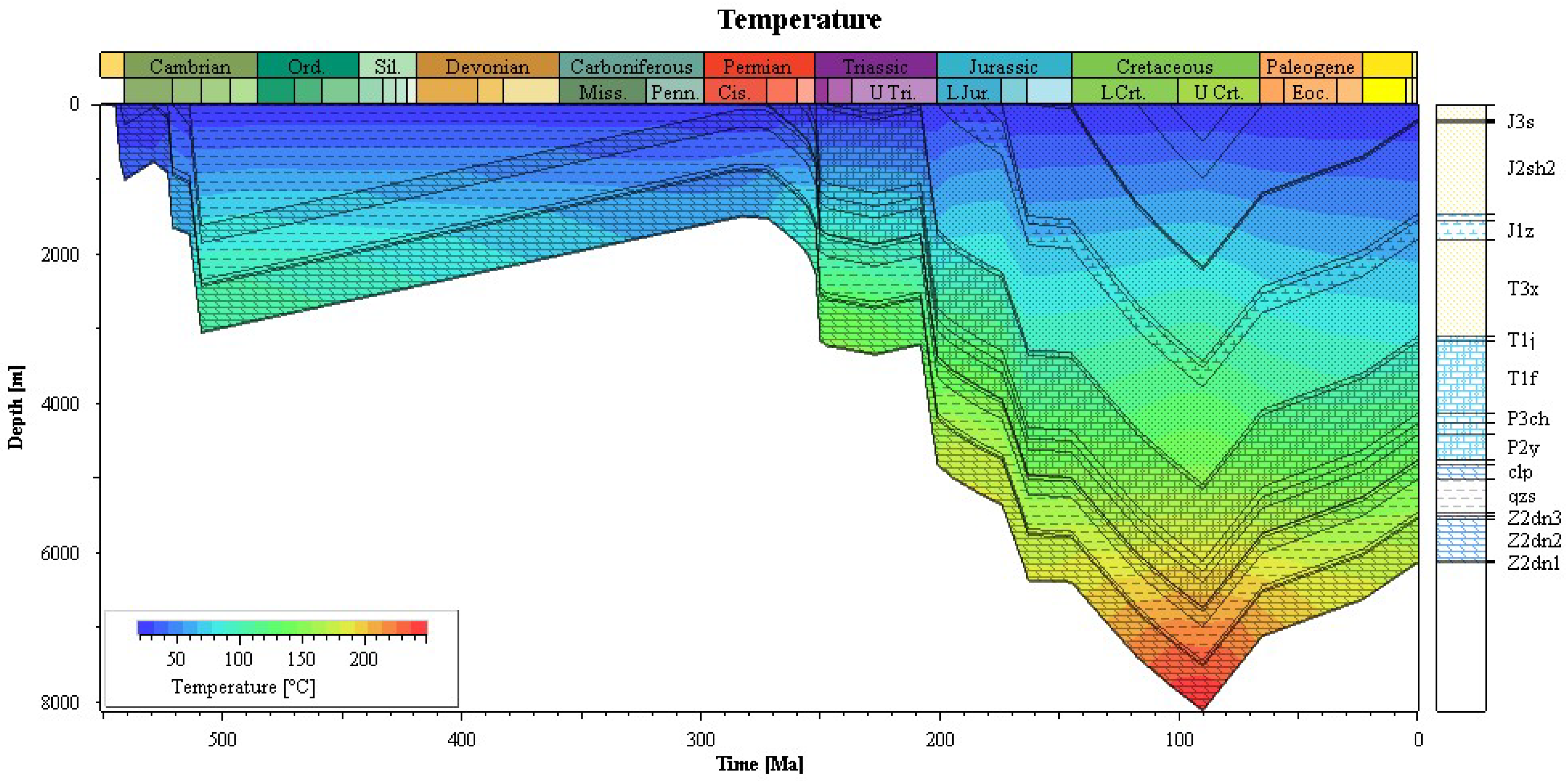

| Well | Coordinate | Stage | Number | Deep | Types | Distance from Fraction | |
|---|---|---|---|---|---|---|---|
| X | Y | ||||||
| PT101 | 3369722 | 18531178 | Z2dn2 | 7 | 5743.26 | II&III | 2~5 km |
| 5744.25 | |||||||
| 5749.80 | |||||||
| 5772.43 | |||||||
| 5773.33 | |||||||
| 5775.75 | |||||||
| 5879.50 | |||||||
| PT1 | 3371786 | 18526227 | Z2dn2 | 5 | 5753.62 | I&II&III | 2~5 km |
| 5761.13 | |||||||
| 5773.12 | |||||||
| 5781.83 | |||||||
| 5787.30 | |||||||
| PT102 | 3374545 | 18531202 | Z2dn2 | 7 | 5853.86 | II&III | <2 km |
| 5857.23 | |||||||
| 5866.60 | |||||||
| 5874.42 | |||||||
| 5874.48 | |||||||
| 5877.83 | |||||||
| 5877.78 | |||||||
| PS106 | 3376740 | 18514474 | Z2dn4 | 3 | 5854.28 | II&III | 2~5 km |
| 5862.34 | |||||||
| 5870.42 | |||||||
| ZJ103 | 3379428 | 18510724 | Z2dn2 | 2 | 5873.09 | I | 2~5 km |
| 5897.48 | |||||||
| DS1 | 3221864 | 18539106 | Z2dn2 | 1 | 6073.3 | III | 2~5 km |
| DB1 | 3405042 | 18531999 | Z2dn4 | 2 | 6409.29 | I | <2 km |
| 6410.10 | |||||||
| ZJ2 | 3392616 | 18492860 | Z2dn2 | 5 | 6546.65 | IV | 2~5 km |
| 6547.13 | |||||||
| 6550.86 | |||||||
| 6551.35 | |||||||
| 6552.81 | |||||||
| PS13 | 3415584 | 18529656 | Z2dn4 | 1 | 6709.80 | I | 5~10 km |
| PS15 | 3412900 | 18520554 | Z2dn4 | 7 | 6774.03 | I&II&III | 2~5 km |
| 6780.01 | |||||||
| 6787.76 | |||||||
| 6787.68 | |||||||
| 6787.76 | |||||||
| 6928.60 | |||||||
| 6929.40 | |||||||
| PS9 | 3434514 | 18580939 | Z2dn4 | 4 | 6897.35 | I | 2~5 km |
| 6970.66 | |||||||
| 6979.46 | |||||||
| 6986.34 | |||||||
| PS8 | 3433685 | 18567381 | Z2dn4 | 3 | 7047.64 | I | 2~5 km |
| 7051.8 | |||||||
| 7061.41 | |||||||
| PS1 | 3430715 | 18529336 | Z2dn4 | 3 | 7258.17 | II | 2~5 km |
| 7260.88 | |||||||
| 7264.85 | |||||||
| DT-1 | 3405615 | 18482676 | Z2dn2 | 5 | 7874.97 | I&IV | 2~5 km |
| 7488.94 | |||||||
| 7508.75 | |||||||
| 7509.96 | |||||||
| PS6 | 3458661 | 18542736 | Z2dn4 | 2 | 7903.52 | I | <2 km |
| 7909.00 | |||||||
| Well | Stage | Depth | Types | WD (cm−1) | WG (cm−1) | ID | IG | FWHM (D/cm−1) | FWHMG (/cm−1) | SD | SG | RBS/cm−1 | R1 | R2 | R3 | Rmc Ro (%) |
|---|---|---|---|---|---|---|---|---|---|---|---|---|---|---|---|---|
| PT101 | Z2dn2 | 5772.43 | III | 1332.1 | 1599.89 | 659.576 | 856.033 | 159.002 | 55.5231 | 15,9795 | 66,608.3 | 267.79 | 0.77 | 2.86 | 2.40 | 3.66 |
| PT1 | Z2dn2 | 5753.62 | III | 1331.11 | 1593.82 | 313.9 | 419.974 | 205.088 | 65.9431 | 81,291.5 | 39,897.1 | 262.71 | 0.75 | 3.11 | 2.04 | 3.63 |
| 5753.62 | II | 1331.39 | 1592.66 | 287.772 | 381.109 | 217.94 | 70.7336 | 75,266.1 | 36,925.8 | 261.27 | 0.76 | 3.08 | 2.04 | 3.64 | ||
| 5761.13 | I | 1327.51 | 1594.1 | 391.805 | 527.542 | 197.174 | 61.8983 | 99,807.6 | 46,957.4 | 266.59 | 0.74 | 3.19 | 2.13 | 3.62 | ||
| PS102 | Z2dn2 | 5857.23 | III | 1331.87 | 1592.83 | 338.538 | 462.916 | 215.077 | 70.3498 | 84,351 | 45,140.5 | 260.96 | 0.73 | 3.06 | 1.87 | 3.61 |
| 5866.6 | II | 1329.45 | 1593.04 | 378.895 | 511.192 | 208.423 | 67.1997 | 95,202.2 | 46,673.3 | 263.59 | 0.74 | 3.10 | 2.04 | 3.62 | ||
| PS106 | Z2dn4 | 5854.28 | II | 1332.98 | 1589.96 | 315.066 | 435.414 | 228.944 | 74.0376 | 80,513.8 | 44,354.4 | 256.98 | 0.72 | 3.09 | 1.82 | 3.60 |
| 5854.28 | III | 1330.04 | 1591.17 | 414.509 | 590.712 | 228.944 | 69.0704 | 104,702 | 56,226.2 | 261.13 | 0.70 | 3.31 | 1.86 | 3.58 | ||
| ZJ103 | Z2dn2 | 5873.09 | I | 1327.89 | 1597.81 | 552.33 | 706.586 | 156.533 | 53.128 | 131,790 | 54,324.1 | 269.92 | 0.78 | 2.95 | 2.43 | 3.67 |
| DS1 | Z2dn2 | 6073.3 | III | 1338.2 | 1601.3 | 146.483 | 152.336 | 120.156 | 53.9096 | 25,871.9 | 11,301.2 | 263.1 | 0.96 | 2.23 | 2.29 | 3.88 |
| DB1 | Z2dn4 | 6409.29 | I | 1329.43 | 1594.67 | 408.351 | 629.028 | 219.087 | 61.2852 | 96,902.5 | 54,685.8 | 265.24 | 0.65 | 3.57 | 1.77 | 3.52 |
| ZJ2 | Z2dn2 | 6546.65 | IV | 1330.29 | 1596.21 | 302.459 | 363.696 | 153.578 | 58.7678 | 70,849.4 | 31,255.3 | 265.92 | 0.83 | 2.61 | 2.27 | 3.73 |
| PS15 | Z2dn4 | 6774.03 | I | 1330.65 | 1591.2 | 309.556 | 420.887 | 222.141 | 70.3986 | 79,005.8 | 40,461.4 | 260.55 | 0.74 | 3.16 | 1.95 | 3.62 |
| 6786.37 | II | 1328.82 | 1592.51 | 409.194 | 540.256 | 200.852 | 66.4065 | 102,146 | 50,766.4 | 263.69 | 0.76 | 3.02 | 2.01 | 3.64 | ||
| 6787.76 | III | 1328.62 | 1591.34 | 480.767 | 651.373 | 228.944 | 72.3626 | 121,094 | 63,410.4 | 262.72 | 0.74 | 3.16 | 1.91 | 3.62 | ||
| PS9 | Z2dn4 | 6897.35 | I | 1329.63 | 1593.51 | 339.336 | 503.497 | 222.709 | 63.3265 | 86,591.6 | 46,703.6 | 263.88 | 0.67 | 3.52 | 1.85 | 3.54 |
| PS8 | Z2dn4 | 7051.8 | I | 1329.2 | 1593.11 | 369.35 | 552.988 | 226.604 | 63.5119 | 93,726.6 | 51,130.4 | 263.91 | 0.67 | 3.57 | 1.83 | 3.54 |
| PS1 | Z2dn4 | 7258.17 | II | 1328.47 | 1593.69 | 365.983 | 537.682 | 216.662 | 62.0269 | 90,594.6 | 48,877.7 | 265.22 | 0.68 | 3.49 | 1.85 | 3.55 |
| DT-1 | Z2dn2 | 7488.94 | IV | 1328.15 | 1597.54 | 401.382 | 490.311 | 152.667 | 55.3394 | 93,477.8 | 39,682.4 | 269.39 | 0.82 | 2.76 | 2.36 | 3.71 |
| 7488.94 | I | 1326.73 | 1597.45 | 415.609 | 501.387 | 140.274 | 51.9973 | 89,146.4 | 38,053.9 | 270.72 | 0.83 | 2.70 | 2.34 | 3.73 | ||
| PS6 | Z2dn4 | 7903.52 | I | 1327.31 | 1599.53 | 556.685 | 761.452 | 151.788 | 48.6566 | 128,920 | 54,980.8 | 272.22 | 0.73 | 3.12 | 2.34 | 3.61 |
| Types | WD (cm−1) | WG (cm−1) | FWHMD (cm−1) | FWHMG (cm−1) | RBS (cm−1) | R1 | R2 | R3 | Rmc Ro (Range) (%) |
|---|---|---|---|---|---|---|---|---|---|
| I (n = 151) | 1328.66 ± 2.24 | 1594.47 ± 2.69 | 196.24 ± 34.29 | 61.03 ± 7.59 | 265.81 ± 4.36 | 0.72 ± 0.05 | 3.20 ± 0.32 | 2.03 ± 0.22 | 3.60 ± 0.06 (3.47–3.74) |
| II (n = 107) | 1329.69 ± 3.00 | 1593.41 ± 2.71 | 212.89 ± 19.55 | 65.53 ± 8.59 | 263.72 ± 4.97 | 0.71 ± 0.05 | 3.28 ± 0.36 | 1.94 ± 0.15 | 3.59 ± 0.06 (3.48–3.69) |
| III (n = 128) | 1329.92 ± 2.82 | 1594.51 ± 2.71 | 200.98 ± 28.08 | 64.28 ± 6.64 | 264.59 ± 3.74 | 0.74 ± 0.06 | 3.12 ± 0.26 | 2.03 ± 0.18 | 3.62 ± 0.07 (3.52–3.89) |
| IV (n = 42) | 1327.37 ± 1.74 | 1597.05 ± 1.24 | 148.47 ± 8.83 | 54.50 ± 2.42 | 269.68 ± 2.05 | 0.80 ± 0.04 | 2.72 ± 0.14 | 2.27 ± 0.15 | 3.70 ± 0.04 (3.46–3.74) |
| Total (n = 428) | 1329.17 ± 2.71 | 1594.47 ± 2.77 | 197.13 ± 32.45 | 62.49 ± 7.92 | 265.30 ± 4.50 | 0.73 ± 0.06 | 3.15 ± 0.34 | 2.03 ± 0.21 | 3.61 ± 0.07 (3.46–3.89) |
| Parameter | I vs. II | I vs. III | I vs. IV | II vs. III | II vs. IV | III vs. IV |
|---|---|---|---|---|---|---|
| WD | t = −3.01, p = 0.003 ** | t = −4.08, p < 0.001 *** | t = 3.98, p < 0.001 *** | t = −0.60, p = 0.55 ns | t = 5.87, p < 0.001 *** | t = 6.96, p < 0.001 *** |
| WG | t = 3.11, p = 0.002 ** | t = −0.12, p = 0.90 ns | t = −8.87, p < 0.001 *** | t = −3.10, p = 0.002 ** | t = −11.22, p < 0.001 *** | t = −8.29, p < 0.001 *** |
| FWHMD | t = −4.94, p < 0.001 *** | t = −1.27, p = 0.21 | t = 15.38, p < 0.001 *** | t = 3.82, p < 0.001 *** | t = 27.65, p < 0.001 *** | t = 18.55, p < 0.001 *** |
| FWHMG | t = −4.35, p < 0.001 *** | t = −3.81, p < 0.001 *** | t = 9.05, p < 0.001 *** | t = 1.23, p = 0.22 ns | t = 12.11, p < 0.001 *** | t = 14.06, p < 0.001 *** |
| RBS | t = 3.50, p < 0.001 *** | t = 2.52, p = 0.012 * | t = −8.14, p < 0.001 *** | t = −1.49, p = 0.14 ns | t = −10.36, p < 0.001 *** | t = −11.13, p < 0.001 *** |
| R1 | t = 1.58, p = 0.11 ns | t = −2.99, p = 0.003 ** | t = −10.82, p < 0.001 *** | t = −4.18, p < 0.001 *** | t = −11.48, p < 0.001 *** | t = −7.37, p < 0.001 *** |
| R2 | t = −1.84, p = 0.07 ns | t = 2.30, p = 0.022 * | t = 14.19, p < 0.001 *** | t = 3.84, p < 0.001 *** | t = 13.67, p < 0.001 *** | t = 12.68, p < 0.001 *** |
| R3 | t = 3.91, p < 0.001 *** | t = 0.00, p = 1.00 ns | t = −8.20, p < 0.001 *** | t = −4.18, p < 0.001 *** | t = −12.08, p < 0.001 *** | t = −8.55, p < 0.001 *** |
| Rmc Ro (%) | t = 0.32, p = 0.189 ns | t = −2054, p = 0.012 ns | t = −12.71, p < 0.001 *** | t = −3.53, p < 0.001 *** | t = −12.99, p < 0.001 *** | t = −9.15, p < 0.001 *** |
Disclaimer/Publisher’s Note: The statements, opinions and data contained in all publications are solely those of the individual author(s) and contributor(s) and not of MDPI and/or the editor(s). MDPI and/or the editor(s) disclaim responsibility for any injury to people or property resulting from any ideas, methods, instructions or products referred to in the content. |
© 2025 by the authors. Licensee MDPI, Basel, Switzerland. This article is an open access article distributed under the terms and conditions of the Creative Commons Attribution (CC BY) license (https://creativecommons.org/licenses/by/4.0/).
Share and Cite
Mo, Y.; Wu, L.; Yang, P.; Liu, K. Rapid Oil Pyrolysis in Ediacaran Carbonate Reservoirs in the Central Sichuan Basin Revealed by Analysis of the Unique Optical and Raman Spectral Features of Pyrobitumen. Appl. Sci. 2025, 15, 12272. https://doi.org/10.3390/app152212272
Mo Y, Wu L, Yang P, Liu K. Rapid Oil Pyrolysis in Ediacaran Carbonate Reservoirs in the Central Sichuan Basin Revealed by Analysis of the Unique Optical and Raman Spectral Features of Pyrobitumen. Applied Sciences. 2025; 15(22):12272. https://doi.org/10.3390/app152212272
Chicago/Turabian StyleMo, Yawei, Luya Wu, Peng Yang, and Keyu Liu. 2025. "Rapid Oil Pyrolysis in Ediacaran Carbonate Reservoirs in the Central Sichuan Basin Revealed by Analysis of the Unique Optical and Raman Spectral Features of Pyrobitumen" Applied Sciences 15, no. 22: 12272. https://doi.org/10.3390/app152212272
APA StyleMo, Y., Wu, L., Yang, P., & Liu, K. (2025). Rapid Oil Pyrolysis in Ediacaran Carbonate Reservoirs in the Central Sichuan Basin Revealed by Analysis of the Unique Optical and Raman Spectral Features of Pyrobitumen. Applied Sciences, 15(22), 12272. https://doi.org/10.3390/app152212272







